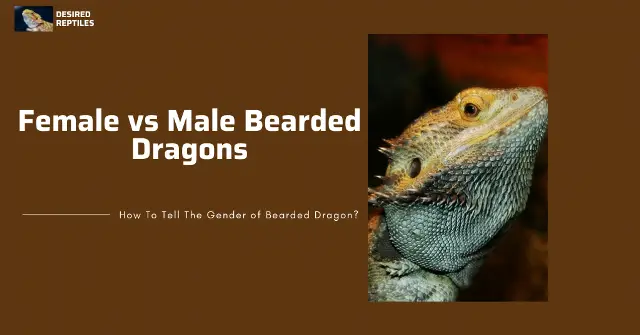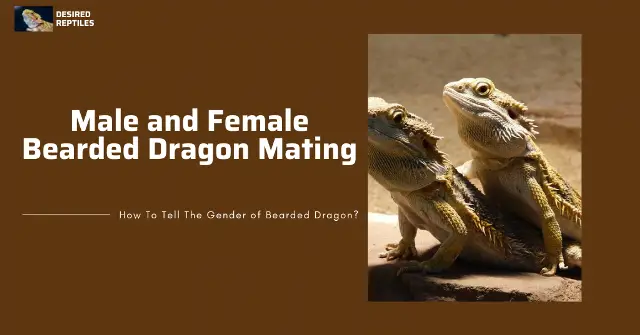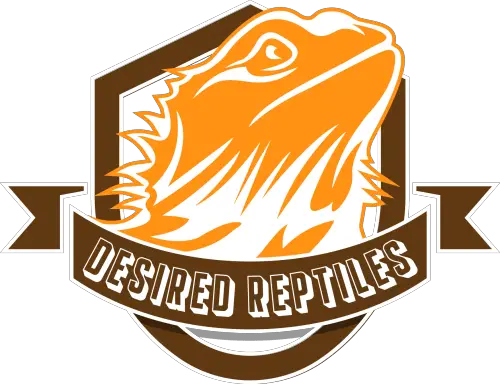Bearded dragons cannot specifically be differentiated based on physical traits alone like variation in color, size, or emblems. Although a distinction in size can be used, it is not at all accurate. For example, we all can tell a male agama lizard from a female just by looking at the coloration since the males dominantly have vibrant yellow, red, and blue hues while the females have gray or brown.
With bearded dragons, your best clue to decipher the gender of your pet is by the presence or absence of hemipenal bulges that reside at the base of the tail, just before the cloaca (anal opening). These bulges, in fact, are the male bearded dragon’s reproductive organs.
Telling apart a male and female beardie can be even more difficult if the dragons are babies, but that’s nothing a good article couldn’t help you clarify. So, let’s get right into it!
4 Major Ways To Tell The Gender Of Your Bearded Dragon
Sexing your bearded dragon can come in different ways. As an expert, I can tell which beardie is male or female just by looking at distinct features that we’ll be discussing as you read. However, if you’re a newbie, you will have to start with the best and most accurate tell-tale sign there is– the hemipenal bulge.
1. Check The Hemipenal Bulge
Hemipenal bulges as I have explained, are simply the male reproductive organ, and here’s how to locate them:
- Position your bearded dragon on your palm head facing your fingers and bottom facing you.
- Carefully lift the tail up till you can see the cloaca.
- At the base of the tail, look for little twin bulges or feel for them with your fingers.
- If present your beardie is male, and if absent, your dragon is a female.
2. Note The Differences In Body Size
Telling the gender of dragons in the wild is much easier to do than with those in captivity. Diet and certain changes can complicate biological disparities, thereby creating striking resemblances between the two sexes.
Nevertheless, the males often have bigger heads and tails and will appear longer than the females in length. You’ll find their heads a little chiseled, and defined with spikes in comparison to females but the tail-to-body ratio is almost equal.
This is notable on most occasions; an exception being specially bred and gender-reversed beardies, which will be discussed later on. The problem with this technique is this. As a newbie, you will need another bearded dragon to note the relative differences and thus, identify the sex of your bearded dragon. However, if you know exactly what you’re looking for, you can tell the gender right off the bat as an expert would.
What to look for:
- Thickness and length of the tail
- Head size
- General body size
- Body-to-tail ratio
- The crown of the head
3. Take A Look At The Femoral Pores
Femoral pores are glands littered underneath the hind legs of bearded dragons that are primarily used to secrete pheromones. These pheromones are used to communicate with other bearded dragons during mating season or used to mark territory as beardies are highly territorial.
For most freely bred beardies, the femoral pores are much more pronounced in comparison to those of the females. In fact, if you take a look at it, you should instantly see the difference. As evolution would have it, the males secrete more pheromones because they dominate the females while possessing territory. This puts their pronounced pores to good use.
4. Observe The Birthing-Belly Structure
Along with the physical differences between the males and females, you can tell the gender of bearded dragons by observing closely how loose or “pouchy” the belly looks. The looseness of the belly is conditioned to accommodate eggs in females, and if you know what to look for, you can immediately tell which dragon is female among a pair. They’d look much rounder and plump around the belly region.

Do Female Bearded Dragons Behave Differently Than Males?
If you are wondering whether your beardie behaves differently based on their gender, the answer is yes. Female bearded dragons do act differently than males; they are less aggressive, much more docile, and portray far less territoriality in comparison.
Although you might not use these facts as a basis to tell the gender of a beardie, females are accustomed to burrowing to lay eggs, waving their arms even more, or flashing their beards less. They will also be more relaxed or easier to tame than the males.
What About The Male Bearded Dragons?
Well, the male dragons on the other hand are a lot more dominant. They are highly territorial and would even fight their reflection for the best basking spot. You’d experience less arm waving, more head bobbing and some serious flashing of the beard when they’re pissed or impressing the females during mating season.
Other behaviors of male berries include burrowing which would be to find a spot to lie down instead of laying eggs like females, arm waving during a defeated fight with a dominant male, and stomping and head bobbing when they’re irritated.
As you can see, these traits are generalized between males and females. It just happens to be that one gender will show more of certain traits in comparison to the other.
Can You Put A Male And Female Bearded Dragon In One Enclosure?
All beardies are solitary species of reptiles that would rather be left alone. It doesn’t matter whether they are a pair of opposite genders, they are highly competitive leading to the weaker dragon getting the short end of the stick.
In a nutshell, putting your male and female beardie in one enclosure is a horrible idea. The female beardie will get half or less of everything they’ll need to survive like UVB rays, shade spots, and even food!
Naturally, females don’t like to compete with males. When and if they do, they always turn out with terrible bruises that could cause more harm than expected. Do not put a male and female bearded dragon in one space.

Female And Male Bearded Dragon Mating Behavior
Since putting a male and female beardie in one enclosure is dangerous, how then do the beardies reproduce?
The only way to breed your dragon safely is to place both healthy adults (at least 18 months old) in the same tank for alternating weeks. That means that you put the female in the tank of the male (not the other way around) for one week and then separate them for a week till they have 3 weeks together.
During this period, both beardies will show their distinct behaviors; the male will have a much more blackened beard and will stomp around to impress his mate, and the female will wave and attempt to run away from the male to prove both submission and acceptance.
This process requires patience from you because they wouldn’t mate right away; they’ll have to get accustomed to their surroundings before reproduction begins.
Female And Male Bearded Dragon Post-Mating Behavior
Female beardies behave differently than normal after mating. After 4 to 6 weeks of breeding, you’ll find them to be more anxious as they’d pace around their enclosure more frequently and would start burrowing for a suitable spot to lay the eggs. They will certainly look plumper than normal and you may even see the imprint of eggs around her belly.
At this point, you should have a lay box (view on Amazon) filled with potting soil (view on Amazon) to enable your dragon to bury her eggs. The laying of eggs occurs mostly during the afternoons to evenings, or even at night when you’re asleep.
If you can’t decide whether or not your beardie has laid her eggs, or are suspecting that they have not laid all the eggs successfully, the vet should be involved to either diagnose the possibilities of egg binding or prevent the complications that come with it which could be fatal.
As for the males, well, aren’t they lucky little fellas! All they have to do is relax and prepare for brumation. Nothing like trotting around with a stomach full of eggs or digging for a spot to lay. The male beardies will generally be less aggressive and more docile after mating is out of the way.
The Fun Part: You Can Reverse The Genders Of Bearded Dragons
As sci-fi as this sounds, you can overturn the gender of a bearded dragon embryo simply by tweaking the temperature of the incubator. This almost fantastical attribute has caught the eye of several scientists worldwide and bearded dragon enthusiasts.
See, beardies have ZZ (female) and ZW (male) chromosomes; when the temperature is 89.6° Fahrenheit, the gender of the embryo is determined by the sex chromosomes. If the temperature goes above 89.6° Fahrenheit, most of the embryos are reversed to females. However, when the temperature is 96.8° Fahrenheit, all the embryos become female!
The most incredible aspect of this genetic reversal is that the male-reversed females (ZZf) will grow up with physical attributes resembling males such as a larger body size but will be able to breed as females, lay eggs, and even make better mothers according to this study from ABC.
This is why and where determining the gender of your bearded dragon based on appearance becomes a hassle, and identifying the gender based on the absence or presence of the hemipenal glands becomes the only way out.
The Verdict
The characteristics and behaviors of male and female bearded dragons are comprehensive. They are highly similar and difficult to differentiate. At the end of the day, checking for hemipenal glands is the most accurate method to decide which gender your dragon is.
With this article, you are fully equipped to decipher the sex of your beardie and give them spectacular names that fit! Remember that veterinary doctors are always a call away to help you through any problems you may encounter, to ensure your pet stays happy and healthy.
